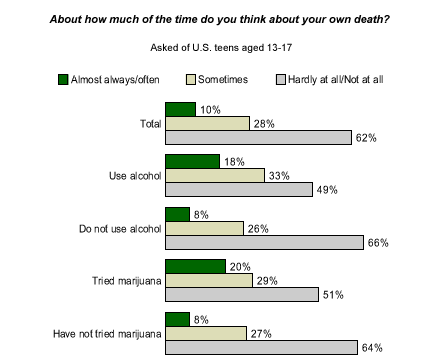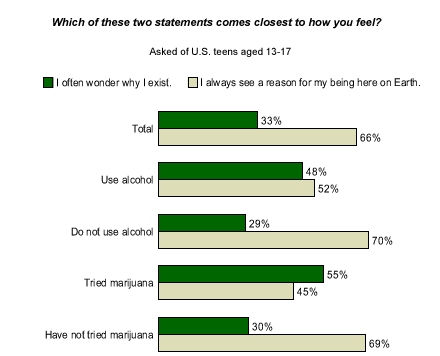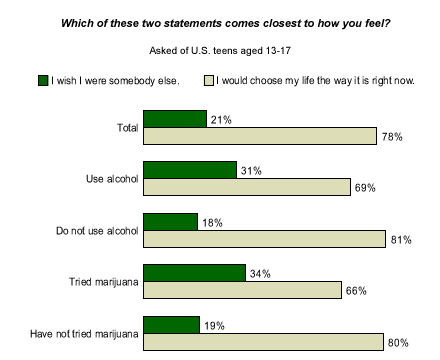Whether it is from parents, teachers, or a billboard along the highway, teens are constantly being warned about the dangers of alcohol and marijuana use. Engaging in these risk behaviors can lead to a host of negative consequences for teens, including physical health problems, family conflicts, legal troubles, and even car accidents. But all these warnings aside, the National Institutes of Health (NIH) reports that 45% of high school teens have consumed at least one alcoholic drink in the past month, and 22% have tried marijuana.
And what about the more hidden psychological and emotional consequences of teen alcohol and drug use? According to a 1999 study by the U.S. Substance Abuse and Mental Health Services Administration, 31% of 12- to 17-year-old drinkers exhibited "extreme levels of psychological distress," and 39% exhibited "serious behavioral problems." A recent Â鶹´«Ã½AV study supports the idea that teens who drink or use marijuana are more likely than other teens to exhibit signs of alienation -- they more frequently express negative thoughts about themselves and contemplate their own deaths.
Alcohol, Marijuana Users More Likely to Think About Death
Aggregated data from two recent Â鶹´«Ã½AV Youth Surveys* show that 10% of U.S. teenagers (aged 13 to 17) think about their own deaths "almost always" or "often," while 62% think about them "hardly at all" or "not at all." But breaking down the data according to alcohol use shows that 18% of teens who drink alcohol think about their deaths almost always or often, compared with just 8% of teens who don't drink alcohol. Less than half of teen drinkers (49%) think about their deaths hardly at all or not at all, compared with two-thirds (66%) of teens who don't drink. An almost identical pattern emerges when looking at teens who have tried marijuana versus those who haven't.

Negative Existential Views
Teens were also asked to choose between the two statements, "I always see a reason for my being here on Earth," and "I often wonder why I exist," to best describe how they feel. Results for this question show the largest gap between substance users and non-users; teens who use alcohol or have tried marijuana are clearly more likely than non-users to choose the latter option. Forty-eight percent of alcohol users, and more than half (55%) of those who have smoked marijuana, often wonder why they exist. In contrast, less than a third of both teens who don't drink alcohol (29%) and those who have never tried marijuana (30%) have this negative existential view.

Teens who drink or use marijuana appear to be less happy with who they are than are teens who don't. Â鶹´«Ã½AV asked respondents to choose between two statements: "I would choose my life the way it is right now" and "I wish I were somebody else." Thirty-one percent of drinkers wish they were somebody else, while 18% of non-drinkers feel this way. Thirty-four percent of teens who have smoked marijuana wish they were someone else, compared with 19% of teens who haven't tried marijuana.

*The Â鶹´«Ã½AV Youth Survey is conducted via an Internet methodology provided by Knowledge Networks, using an online research panel that is designed to be representative of the entire U.S. population. The questionnaires were completed by 1,302 respondents aged 13 to 17 between Aug. 1-29, 2003, and Jan. 22-March 9, 2004. For results based on the total sample, one can say with 95% confidence that the maximum margin of sampling error is ±2 percentage points.
For results based on the subsample of 314 teens who have had occasion to consume alcohol, the maximum margin of sampling error is ±6 percentage points. For results based on the subsample of 977 teens who have not had occasion to consume alcohol, the maximum margin of sampling error is ±3 percentage points. For results based on the subsample of 173 teens who have tried marijuana, the maximum margin of sampling error is ±8 percentage points. For results based on the subsample of 1,119 teens who have not tried marijuana, the maximum margin of sampling error is ±3 percentage points.